Dogs


History
Reputedly, the breed started when one hairless puppy appeared in one Rat Terrier litter in the state of Louisiana, United States, in 1972. Owners Edwin and Willie Scott liked the dog's look and temperament, and upon maturity bred her hoping to reproduce the hairless quality. They were eventually successful; a litter produced in 1981 provided the foundation stock of the breed.
Recognition

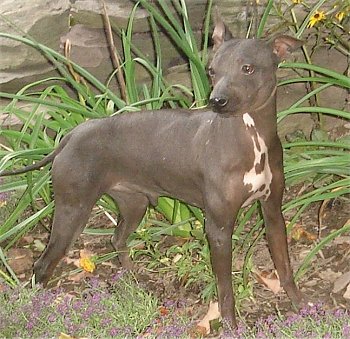
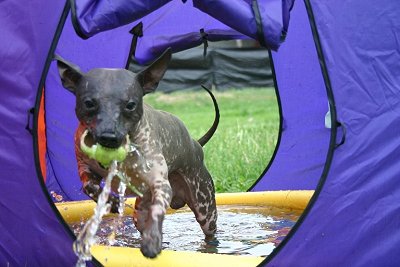
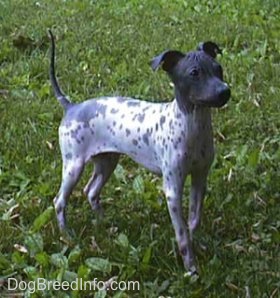
Height, Weight
Height: 7-16 inches (18-41 cm.)
Weight: 5-16 pounds (2.5-7 kg.)
Health Problems

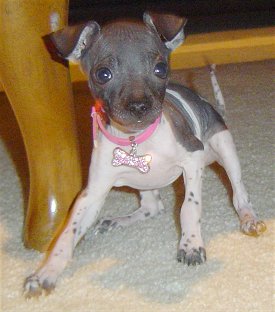


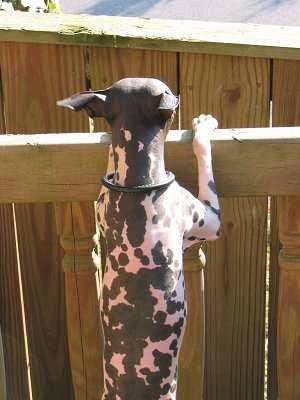
- The Sphynx, A Hairless Cat With A Charming Purrsonality
By Julia Williams I vividly remember the first time I ever came face to face with a Sphynx cat. My friend and I were making the rounds at a cat show, oohing and aahing at all the beautiful kitties with their luxurious, fluffy coats brushed to perfection....
- Chinese Crested Small Breed Dog
The Chinese Crested Dog is a smaller (10–13 lbs) hairless breed of dog. Like most hairless dog breeds, the Chinese Crested comes in two varieties, both with and without fur, which are born in the same litter: the Hairless and the Powderpuff....
- Small Dogs That Don't Shed
Shedding is one of the biggest complaints that dog owners have. Apart from the annoying chore of cleaning piles of dog hair, shedding can also be a health hazard for people suffering from allergies and asthma. Common allergens that cause a flare-up include...
- Best Small Dogs
Dog lovers don't discriminate between big and small dogs. Dogs are dogs they say. That might be and I'm not arguing one tiny bit. But here's the deal, what about those who have limited space or want to get a small dog for their kids or...
- Best House Dogs
The very fact that you are reading this article means that you are giving the breed and the kind of dog to get for your home, a serious thought. You want the decision to be absolutely correct and for that, you need information about the kinds of...
Dogs
American Hairless Terrier small dog breed

The American Hairless Terrier is a breed of dog that was formerly considered a variant of Rat Terrier. As of January 1, 2004, the United Kennel Club deemed the AHT a separate terrier breed. It is often mistaken for a hairless Chihuahua.

History
Reputedly, the breed started when one hairless puppy appeared in one Rat Terrier litter in the state of Louisiana, United States, in 1972. Owners Edwin and Willie Scott liked the dog's look and temperament, and upon maturity bred her hoping to reproduce the hairless quality. They were eventually successful; a litter produced in 1981 provided the foundation stock of the breed.
Recognition

In 1998 the breed gained recognition as the American Hairless Terrier by the American Rare Breeds Association and the National Rat Terrier Club. Canada was the first country outside the US to gain recognition, by Canadian Rarities in 1999. In 1999 the breed was recognized as Rat Terrier, Hairless Variety by the United Kennel Club. The UKC is the only governing body that recognizes the breed. While this organization is a national body, the breed is waiting for an international official breakthrough.
In the US the American Hairless Terrier Association is the provisional breed club. Other National Breed Clubs around the world include the Canadian American Hairless Terrier Association and the Japanese Hairless American Terrier Club.
In the US the American Hairless Terrier Association is the provisional breed club. Other National Breed Clubs around the world include the Canadian American Hairless Terrier Association and the Japanese Hairless American Terrier Club.
About
An adult American Hairless Terrier - Courtesy of Horizon AHTs. "This breed of dog is excellent for allergy sufferers. They have absolutely no body hair, no dander. Most people who cannot tolerate a Bichon, Poodle, Yorkie, or Wheaton Terrier can tolerate this breed. An allergy test is recommended before buying any breed where allergies or asthma are a problem."
Description
In build, the American Hairless Terrier is identical to the medium-sized Rat Terriers, from whom he is directly descended. The American Hairless is a well-muscled dog with a deep chest, strong shoulders, solid neck, and powerful legs. The ears are carried erect when the dog is alert and are called bat, similar to the Rat Terrier's. Tails must be full length. Bobs, either natural or docked are a disqualification.
Description
In build, the American Hairless Terrier is identical to the medium-sized Rat Terriers, from whom he is directly descended. The American Hairless is a well-muscled dog with a deep chest, strong shoulders, solid neck, and powerful legs. The ears are carried erect when the dog is alert and are called bat, similar to the Rat Terrier's. Tails must be full length. Bobs, either natural or docked are a disqualification.
The skin is pink with gray, black, golden or red spots. Hairless-to-hairless breeding always produces completely hairless puppies. Hairless-to-coated mating is producing variable results, depending on chances and whether the coated dog is a carrier of the hairless trait. Hairless pups are born with a bit of sparse fuzzy hair all over their body. The pup will shed this fuzz, starting with the head, proceeding backwards, becoming entirely and eternally hairless by the age of six weeks. They do not have tufts of hair on the head, feet and end of tail, as do the Chinese Crested. They do however, have normal eyebrows and whiskers.
Temperament
Temperament
American Hairless Terriers are intelligent, alert, playful and loving dogs. Very inquisitive and lively. This affectionate dog makes an excellent companion for anyone. They are good with children, especially if they are raised with them from puppyhood. The American Hairless Terrier, unlike other dog breeds, will break out in a sweat when hot or scared. They are fairly territorial, and like all dogs, need a human who understands how to be his leader. For the most part friendly with strangers. AHT's make good watchdogs. They are not good swimmers and need to be closely monitored. These dogs are quick and very playful. The temperament of these dogs is pure terrier. They have the lively, feisty, fearless nature found in the best of terriers. Ratting cannot be recommended, due to the increased vulnerability brought on by the lack of a protective coat. This breed seems to train easily and are eager to please. Small dogs have the tendency to lack in human leadership. Be sure you are this dogs true pack leader in order to curve any negative behaviors.
Height, Weight
Height: 7-16 inches (18-41 cm.)
Weight: 5-16 pounds (2.5-7 kg.)
Health Problems
These dogs do not have absent premolars or any of the breeding complications associated with the hairless breeds. The AHT does not have the major skin problems commonly seen in hairless dogs. Sometimes they will get a rash on their skin. Because of their lack of hair, they do need protection from the sun. Sunscreen should be applied or a shirt should be worn, not only for the protection from the sun but from the cold as well. AHT's do have sweat glands and will get pimples! They go away on their own. Rashes due to grass allergies are not that uncommon. Other allergies do occur as well.
Living Conditions
Living Conditions
The AHT will do ok in an apartment so long as they get at least 20-30 minutes of exercise a day. They are fairly active indoors and should have at least a small to medium sized yard. AHT's love to dig. Since they have sweat glands they do not drool at the mouth or pant in order to balance their body heat. They should wear a sweater in cold weather.
Exercise
The breed enjoys challenging games and outdoor romps. They need to be taken on a long daily walk.
Life Expectancy
About 14-16 years.
Grooming
Exercise
The breed enjoys challenging games and outdoor romps. They need to be taken on a long daily walk.
Life Expectancy
About 14-16 years.
Grooming
The only special care required is preventing sunburn and keeping them warm in cold weather. They should be bathed one to three times a week, owners preference. Their nails should be trimmed weekly. If their skin becomes dry, lotion (without lanolin) can be applied. This breed obviously does not shed and they do not get fleas, but they do shed skin cells about every 20 days, therefore there is some dander but it is very minimal. AHT's forget they do not have any hair and romp around outside. Scratches and cuts do happen and they need to be attended to by hydrogen peroxide or any other antiseptic agent.
This breed is very good for allergy sufferers. Many AHT breeders have experiences , doing hands on and remote allergy tests with people who have allergic responses to dogs and more often than not, individuals who can not tolerate even those breeds who are known to be 'hypoallergenic'... can tolerate an AHT. Studies have found them to be the best breed of dog for people with dog allergies. Many breeders can recount stories of grown men crying at the prospect of owning a dog for the first time in their lives. For those individuals and families who have never owned a dog before either due to their own allergies or a family members , holding a dog for the first time without a reaction is a rather powerful feeling for them.. !
Origin
This breed is very good for allergy sufferers. Many AHT breeders have experiences , doing hands on and remote allergy tests with people who have allergic responses to dogs and more often than not, individuals who can not tolerate even those breeds who are known to be 'hypoallergenic'... can tolerate an AHT. Studies have found them to be the best breed of dog for people with dog allergies. Many breeders can recount stories of grown men crying at the prospect of owning a dog for the first time in their lives. For those individuals and families who have never owned a dog before either due to their own allergies or a family members , holding a dog for the first time without a reaction is a rather powerful feeling for them.. !
Origin

In 1972, a remarkable thing happened: in a litter of mid-sized Rat Terriers, a completely hairless female was born. It became the prized pet of Willie and Edwin Scott of Louisiana, U.S.A. They named their hairless dog Josephine. The Scotts bred Josephine and produced one hairless female in her first litter, but through the next several litters, the little terrier failed to whelp any more exhibiting the hairless trait. Finally, at the age of nine years, she crowned her attempts by having a litter with two hairless pups, one of each sex. These hairless pups where the foundation of a breeding program to produce and stabilize the breed. The Scotts worked under the guidance of their geneticist and veterinarian. They named their new breed American Hairless Terrier. These are not just freak dogs. They differ substantially from the hairless types of Asia and Africa in that no Powderpuff variety is needed to obtain hairless pups, as the hairlessness gene is not semi-lethal dominant but autosomal recessive. Furthermore, these dogs do not have absent premolars or any of the breeding complications associated with the hairless breeds. For these traits, the Scott's nude puppy and its progeny are truly remarkable and unique in the canine world. The Scotts are still working on establishing this breed. They are working toward keeping the temperament of the Rat Terrier while still maintaining the hairless trait.
Group
Terrier
Recognition
UKC, NKC, AHTF, AHRTC, CKC, APRI, ACR, DRA
The AHRTC is licensed by United Kennel Club . The breed is now recognized with UKC as a rat terrier/ hairless variety but will become a separate breed with UKC on Jan 1, 2004. The AHRTC will be then known as the AHTA, American Hairless Terrrier Association and the Provisional Parent Club for this breed with UKC.
Terrier
Recognition
UKC, NKC, AHTF, AHRTC, CKC, APRI, ACR, DRA
The AHRTC is licensed by United Kennel Club . The breed is now recognized with UKC as a rat terrier/ hairless variety but will become a separate breed with UKC on Jan 1, 2004. The AHRTC will be then known as the AHTA, American Hairless Terrrier Association and the Provisional Parent Club for this breed with UKC.
- The Sphynx, A Hairless Cat With A Charming Purrsonality
By Julia Williams I vividly remember the first time I ever came face to face with a Sphynx cat. My friend and I were making the rounds at a cat show, oohing and aahing at all the beautiful kitties with their luxurious, fluffy coats brushed to perfection....
- Chinese Crested Small Breed Dog
The Chinese Crested Dog is a smaller (10–13 lbs) hairless breed of dog. Like most hairless dog breeds, the Chinese Crested comes in two varieties, both with and without fur, which are born in the same litter: the Hairless and the Powderpuff....
- Small Dogs That Don't Shed
Shedding is one of the biggest complaints that dog owners have. Apart from the annoying chore of cleaning piles of dog hair, shedding can also be a health hazard for people suffering from allergies and asthma. Common allergens that cause a flare-up include...
- Best Small Dogs
Dog lovers don't discriminate between big and small dogs. Dogs are dogs they say. That might be and I'm not arguing one tiny bit. But here's the deal, what about those who have limited space or want to get a small dog for their kids or...
- Best House Dogs
The very fact that you are reading this article means that you are giving the breed and the kind of dog to get for your home, a serious thought. You want the decision to be absolutely correct and for that, you need information about the kinds of...
